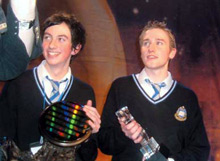| 2005 |

|
YEAR BOOK |
Synge Street Christian Brothers' School, Dublin
|
Numerical solutions of Hamilton's equations
|
The formulation of the laws of mechanics that is familiar to most people is that of Newton (about 1670).
In 1834 William Rowan Hamilton wrote one of his most famous scientific papers. The title of this paper was On a General Method in Dynamics and in it he showed that the motion of a mechanical system could be described by the set of differential equations now known as Hamilton's equations.
There are two ways of solving Hamilton's equations. The first way seeks to express the solution as a set of mathematical formulas for the co-ordinates and momenta of the system. Hamilton's equations are so complex that in most cases this approach to their solution is impractical. An alternative method is to use a computer to plot the trajectory of the system. The mathematical basis for any simulation technique must be very carefully thought out, otherwise the simulation will not output the true motion of the system.
In our project we propose and test a new numerical method of solving Hamilton's equations. There is a standard numerical analysis method of solving equations similar to Hamilton's equations � it is known as the fourth-order Runge-Kutta method. Equations similar to Hamilton's may arise in fields as diverse as economics and biology and the Runge-Kutta method is a very accurate way of solving such equations. But mechanical systems contain extra information which the Runge-Kutta method does not use in the solution process.
In many mechanical systems a conservation law, such as conservation of energy or angular momentum, may hold. It is common practice to use the conservation law as a check on the accuracy of the simulation. What is new about the algorithm described in our project is that the conservation law is incorporated into the solution process itself, combining the information contained in the conservation law with Hamilton's equations to calculate the new values of the generalised co-ordinates and momenta.
We analysed the position, momentum and energy errors of simulations of various mechanical systems. The accuracy of these simulations was tested in two ways. In some simple systems the output of the new algorithm can be compared to the analytical solution. Where the problem is very complex and an analytical solution is not available, the output is compared to that of the Runge-Kutta method.

| This article was sponsored by Oldbury Publishing Limited |
|---|